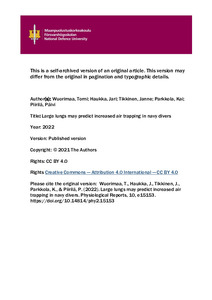Large lungs may predict increased air trapping in navy divers
Wuorimaa, Tomi; Haukka, Jari; Tikkinen, Janne; Parkkola, Kai; Piirilä, Päivi (2022)
Wuorimaa, Tomi
Haukka, Jari
Tikkinen, Janne
Parkkola, Kai
Piirilä, Päivi
2022
Tiivistelmä
Navy divers tend to have large lungs and low expiratory flow rates in the ter-minal portion of a spirogram. We examined Finnish Navy divers for the pres-ence of air trapping, airway obstruction, and functional airway compression, and their association with lung volumes. Divers (n = 57) and non- diving men (n = 10) underwent a variety of pulmonary function tests. The amount of trapped air was calculated as the subtraction of the total lung capacity (TLC) measured in a single- breath helium dilution test from the TLC in body plethysmography (TLCb). Mean vital capacity (VC) was 6.4 L in the divers versus 5.8 L in the controls (p = 0.006) and TLCb 8.9 L in the divers versus 8.1 L in the controls (p = 0.002). No difference existed between them in the amount of trapped air. However, we found break points in a linear regression model (Davies test) be-tween trapped air and several pulmonary parameters. Those individuals above the break points had lower ratio of forced expiratory volume in first second to forced vital capacity, lower resistance of airways, and higher reactance than those below the break points. In conclusion, navy divers had larger lungs than controls. Large lung volumes (VC >7.31 L or >122% of predicted value) were associated with air trapping. Furthermore, large volumes of air trapping (>1.1 L) were asso-ciated with increased residual volume (RV) and RV/TLCb. Despite no concurrent obstruction, functional airway compression, or reduced diffusing capacity, this slowly ventilated trapped air might remain disadvantageous for divers.KEYWORDS air trapping, diving, large lungs, obstruction, reserve volume
Kokoelmat
- Artikkelit [106]
